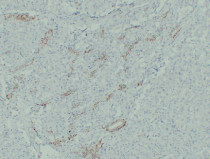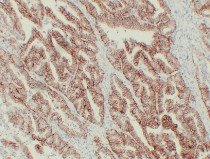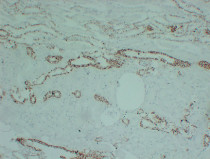ARG66569
anti-Claudin 7 antibody
anti-Claudin 7 antibody for IHC-Formalin-fixed paraffin-embedded sections,Western blot and Human
Overview
| Product Description | Mouse Monoclonal antibody recognizes Claudin 7 |
|---|---|
| Tested Reactivity | Hu |
| Tested Application | IHC-P, WB |
| Host | Mouse |
| Clonality | Monoclonal |
| Isotype | IgG2a, kappa |
| Target Name | Claudin 7 |
| Antigen Species | Human |
| Immunogen | Synthetic peptide derived from Human Claudin 7. |
| Conjugation | Un-conjugated |
| Alternate Names | Claudin-7; CEPTRL2; claudin-1; CPETRL2; CLDN-7; Hs.84359 |
Application Instructions
| Application Suggestion |
|
||||||
|---|---|---|---|---|---|---|---|
| Application Note | IHC-P: Antigen Retrieval: Boil tissue section in Citrate buffer (pH 6.0). * The dilutions indicate recommended starting dilutions and the optimal dilutions or concentrations should be determined by the scientist. |
||||||
| Observed Size | ~ 20 kDa |
Properties
| Form | Liquid |
|---|---|
| Purification | Affinity purification with immunogen. |
| Buffer | PBS, 0.02% Sodium azide, 50% Glycerol and 0.5% BSA. |
| Preservative | 0.02% Sodium azide |
| Stabilizer | 50% Glycerol and 0.5% BSA |
| Concentration | 1 mg/ml |
| Storage Instruction | For continuous use, store undiluted antibody at 2-8°C for up to a week. For long-term storage, aliquot and store at -20°C. Storage in frost free freezers is not recommended. Avoid repeated freeze/thaw cycles. Suggest spin the vial prior to opening. The antibody solution should be gently mixed before use. |
| Note | For laboratory research only, not for drug, diagnostic or other use. |
Bioinformation
| Database Links | |
|---|---|
| Gene Symbol | CLDN7 |
| Gene Full Name | claudin 7 |
| Background | This gene encodes a member of the claudin family. Claudins are integral membrane proteins and components of tight junction strands. Tight junction strands serve as a physical barrier to prevent solutes and water from passing freely through the paracellular space between epithelial or endothelial cell sheets, and also play critical roles in maintaining cell polarity and signal transductions. Differential expression of this gene has been observed in different types of malignancies, including breast cancer, ovarian cancer, hepatocellular carcinomas, urinary tumors, prostate cancer, lung cancer, head and neck cancers, thyroid carcinomas, etc.. Alternatively spliced transcript variants encoding different isoforms have been found.[provided by RefSeq, May 2010] |
| Function | Plays a major role in tight junction-specific obliteration of the intercellular space. [UniProt] |
| Cellular Localization | Cell membrane; Multi-pass membrane protein. Basolateral cell membrane. Cell junction, tight junction. Note=Co-localizes with EPCAM at the basolateral cell membrane and tight junction. [UniProt] |
| Calculated MW | 22 kDa |
| PTM | Phosphorylated. [UniProt] |
Images (4) Click the Picture to Zoom In
-
ARG66569 anti-Claudin 7 antibody IHC-P image
Immunohistochemistry: Paraffin-embedded Human chromophobe cell renal carcinoma tissue stained with ARG66569 anti-Claudin 7 antibody at 1:200 dilution (4°C, overnight). Antigen Retrieval: Boil tissue section in Citrate buffer (pH 6.0).
-
ARG66569 anti-Claudin 7 antibody WB image
Western blot: 30 µg of LnCap whole cell lysate stained with ARG66569 anti-Claudin 7 antibody at 1:1000 dilution.
-
ARG66569 anti-Claudin 7 antibody IHC-P image
Immunohistochemistry: Paraffin-embedded Human colon carcinoma tissue stained with ARG66569 anti-Claudin 7 antibody at 1:200 dilution (4°C, overnight). Antigen Retrieval: Boil tissue section in Citrate buffer (pH 6.0).
-
ARG66569 anti-Claudin 7 antibody IHC-P image
Immunohistochemistry: Paraffin-embedded Human kindey tissue stained with ARG66569 anti-Claudin 7 antibody at 1:200 dilution (4°C, overnight). Antigen Retrieval: Boil tissue section in Citrate buffer (pH 6.0).









